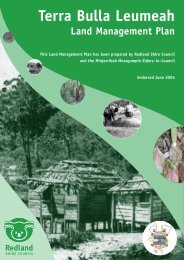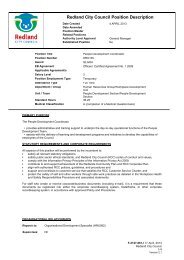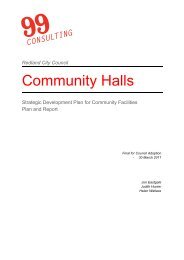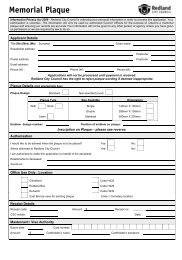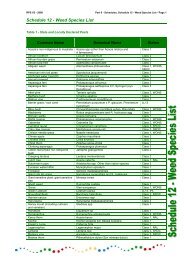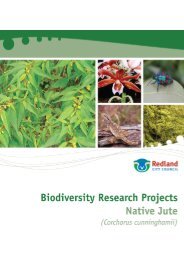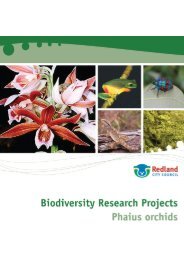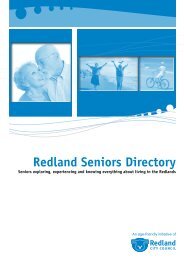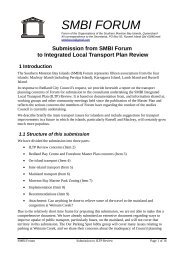Land for Wildlife Newsletter - IndigiScapes
Land for Wildlife Newsletter - IndigiScapes
Land for Wildlife Newsletter - IndigiScapes
You also want an ePaper? Increase the reach of your titles
YUMPU automatically turns print PDFs into web optimized ePapers that Google loves.
letters to the editor<br />
Ragamuffin Earth<br />
In response to Spencer Shaw’s weed profile<br />
(October 2012), you may be familiar with<br />
the term ‘novel ecosystem’. This is defined<br />
as an ecosystem that has been influenced<br />
by humans, but is not under human<br />
management.<br />
An article entitled ‘Ragamuffin Earth’ in<br />
Nature Collections (March 2010) defines<br />
novel ecosystems as “land without<br />
agricultural or urban use, embedded<br />
with agricultural or urban regions”. This, I<br />
believe, is what most of we <strong>Land</strong> <strong>for</strong> <strong>Wildlife</strong><br />
/ conservationists / regenerationists have<br />
to work with – ecosystems that we can<br />
make habitable <strong>for</strong> flora and fauna and<br />
provide some ecosystem services, but<br />
which will also contain introduced species<br />
of varying degrees of benefit. Property<br />
profiles in the <strong>Land</strong> <strong>for</strong> <strong>Wildlife</strong> newsletters<br />
are mostly about such ecosystems. (Is it<br />
reasonable to suggest that the introduction<br />
of Mus musculus [house mouse] has been<br />
beneficial? After all, brown snakes like<br />
them).<br />
And Spencer Shaw points out that not all<br />
weeds are bad – or not ‘all bad’.<br />
Cobbler’s Pegs are vigorous and annoying<br />
pioneer plants. I can successfully grow<br />
them to a greater than head height in<br />
a good season on new ground. Native<br />
bees like them and dead plants are<br />
good kindling. But as my largely native<br />
garden develops, the Cobbler’s Pegs are<br />
diminishing and my socks are becoming<br />
less uncom<strong>for</strong>table.<br />
Lantana? Hmm… Well after the 2010/11<br />
severe torrents that raged down my little<br />
creek, if it had not been <strong>for</strong> Lantana camara<br />
plants on the banks, erosion would have<br />
been much worse. I only wish we had as<br />
vigorous a native replacement. Native<br />
Cockspur (Maclura cochinchinensis) might<br />
qualify, but with comparable discom<strong>for</strong>t<br />
and inconvenience.<br />
At present, my favourite weed is Ink<br />
Weed (Phytolacca octandra) which was<br />
well established be<strong>for</strong>e we bought here<br />
four years ago. It grows quickly into a<br />
quite attractive shrub, is reasonably easy<br />
to remove when necessary, makes good<br />
mulch, shades new plants and attracts<br />
a wide range of birds. In addition to<br />
the many LBBs (little brown birds) and<br />
LGBs (little grey birds) that I have yet to<br />
identify, visitors include Koels, Silvereyes<br />
by the dozen, three kinds of wren (Superb,<br />
Variegated and Red-winged Fairy-wrens),<br />
Brown Cuckoo-doves, Pale-headed<br />
Rosellas, Lewin’s Honeyeater, Red-browed<br />
Finches and others.<br />
Above left: The orange fruit of Cockspur.<br />
Would this prickly native plant work as a<br />
replacement <strong>for</strong> lantana?<br />
Above right: Inkweed fruit attracts a wide<br />
range of birds. Photos by Rob Whyte.<br />
Surprisingly, despite there being a<br />
resident population, I have yet to see Pied<br />
Currawongs eating the fruit or going into<br />
the Ink Weed after small birds.<br />
Past experience with such weeds as Lime<br />
Bush (Eremocitrus glauca) and Galvanised<br />
Burr, leads me to believe that they are the<br />
dominant remnant species on over-used<br />
land because they are relatively inedible. I<br />
suspect this also applies to Bursaria spinosa.<br />
Anything is better than bare ground - even<br />
Prickly Pear has very attractive flowers. I<br />
confess to finding complimentary things<br />
to say about Noogoora and Bathurst Burrs<br />
difficult. Perhaps some readers could assist<br />
me here.<br />
Having said all this, my proof-reader has<br />
now advised that I am only seeking to<br />
justify the fact that I am a lazy, disorganised<br />
gardener / landscaper who hates weeding.<br />
Peter Darvall<br />
<strong>Land</strong> <strong>for</strong> <strong>Wildlife</strong> member<br />
Stockyard, Lockyer Valley<br />
Multiple Bowers<br />
Re Satin Bowerbird High Density Bowers<br />
in Fauna Vignettes (<strong>Land</strong> <strong>for</strong> <strong>Wildlife</strong> SEQ<br />
<strong>Newsletter</strong> October 2012) there are several<br />
explanations.<br />
1. There appears to be only one<br />
functioning bower although the display<br />
material covers the other bower. There<br />
would seem no evolutionary advantage<br />
in constructing two bowers other than<br />
practice. The picture may even show<br />
three bowers! Younger birds improve<br />
construction over time. The cost of<br />
maintaining (constructing, decorating,<br />
painting, defending) two bowers in<br />
working order at the same time would<br />
surely outweigh the small advantage of<br />
giving a female a choice.<br />
2. The resident failed to attract mates to the<br />
original bower and so built another. There<br />
appears adequate construction material on<br />
the floor nearby obviating the necessity of<br />
using old bower material.<br />
3. The original occupier died or was<br />
displaced. The new occupier chose to<br />
build a new bower because, (a) the old<br />
bower contained saliva and/or scent of<br />
the previous occupier, or (b) there was<br />
adequate building material.<br />
There appears little in the literature on this<br />
matter but the following paper may be<br />
of help: Bravery BD & Goldizen AW (2007)<br />
Male satin bowerbirds compensation <strong>for</strong><br />
sexual signal loss by enhancing multiple<br />
display features. Naturwissenschaften 94(6),<br />
pp 473-476.<br />
Gordon Wilkinson<br />
<strong>Land</strong> <strong>for</strong> <strong>Wildlife</strong> member<br />
Brookfield, Brisbane<br />
<strong>Land</strong> <strong>for</strong> <strong>Wildlife</strong> South East Queensland January 2013 15



